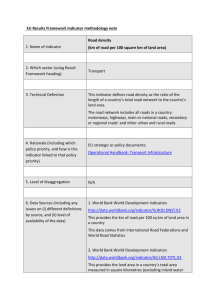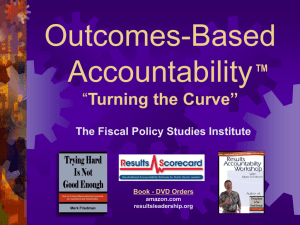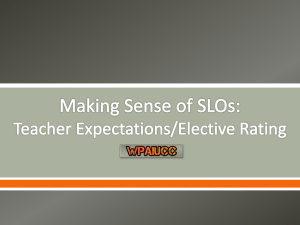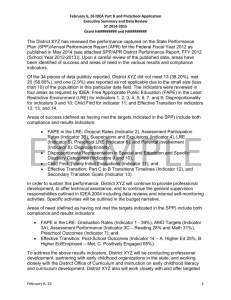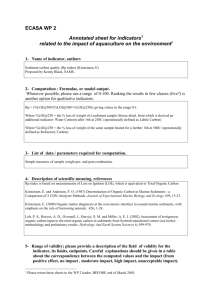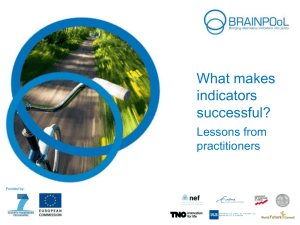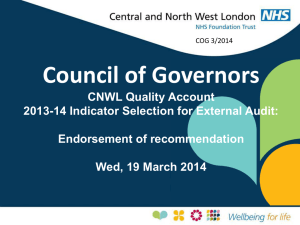Results and Performance Accountabilty, Decision
advertisement
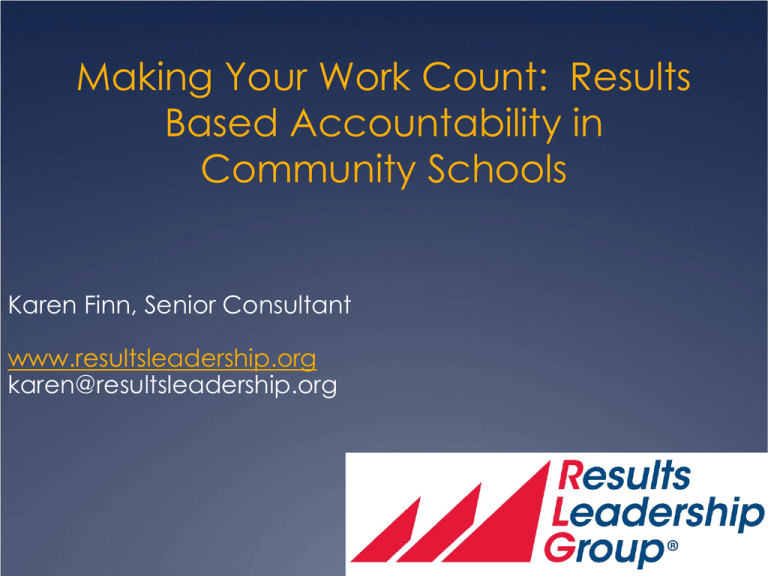
Making Your Work Count: Results Based Accountability in Community Schools Karen Finn, Senior Consultant www.resultsleadership.org karen@resultsleadership.org What is Results-Based Accountability (RBA)? A disciplined way of thinking and taking action that communities can use to improve the lives of children, youth, families and the community as a whole. It can also be used to improve the performance of programs, agencies and service systems. Based on the work of Mark Friedman: WEBSITES: www.raguide.org www.resultsaccountability.com BOOK and DVD ORDERS: www.trafford.com www.resultsleadership.org SIMPLE COMMON SENSE PLAIN LANGUAGE MINIMUM PAPER USEFUL Results Accountability is about… Unified purpose: focusing the energy of multiple partners on continuously improving the most important measures of well-being Transparency: Using data and effective questions to access facts and the “story behind the facts” to move quickly to action Communication power: Being able to tell your story in the most compelling and datadriven way RBA in a Nutshell 2–3–7 2 Kinds of Accountability plus Language Discipline • Population- or Community-Level Quality of Life • (Results & Indicators) • Performance- or Program-Level • (Performance Measures) 3 Kinds of Performance Measures • How much did we do? • How well did we do it? • Is anyone better off? 7 Questions From Ends to Means (In less than an hour) 6 Starting at the “End” The well-being of WHOLE POPULATIONS Communities – Cities – Counties – States - Nations The well-being of Customer POPULATIONS Programs – Agencies-Schools – and Service Systems FPSI/RLG 7 Leaking Roof (Results thinking in everyday life) Experience: Inches of Water Measure: Not OK ? Fixed Turning the Curve Story behind the baseline (causes): Partners: What Works: Action Plan: The 7 Effective Questions of Population Accountability 1 What are the quality of life conditions we want for our children, youth, families and communities? (Results) 2 How will we measure these conditions? (indicators) 3 How are we doing on the most important measures? (baseline) and where will these measures be if we do nothing differently? (forecast) 4 What is the story behind the baseline? 5 Who are our partners with a role to play to help us do better? 6 What works to improve our baseline? 7 What do we propose to do? THE LANGUAGE TRAP Too many terms. Too few definitions. Too little discipline Benchmark Outcome Result Modifiers Indicator Measurable Core Urgent Qualitative Priority Programmatic Targeted Performance Incremental Strategic Systemic Measure Goal Objective Target Lewis Carroll Center for Language Disorders DEFINITIONS RESULT A condition of well-being for children, adults, families or communities. Children born healthy, Children succeeding in school, Safe communities, Clean Environment, Prosperous Economy INDICATOR A measure which helps quantify the achievement of a result. Rate of low-birthweight babies, Rate of high school graduation, crime rate, air quality index, unemployment rate PERFORMANCE MEASURE A measure of how well a program, agency or service system is working. 1. How much did we do? Three types: 2. How well did we do it? 3. Is anyone better off? = Customer Results or Outcomes From Ends to Means From Talk to Action RESULT ENDS INDICATOR PERFORMANCE MEASURE Customer result = Ends Service delivery = Means MEANS POPULATION ACCOUNTABILITY For Whole Populations in a Geographic Area On the worksheet… Define your community (Neighborhood, city, catchment area) Think about your community and complete the following sentences: We want children who are……. We want youth who are….. We want families who are….. We want schools that are….. We want our community to be….. Maryland Child Well-Being Results Babies born healthy Healthy children Children enter school ready to learn Children are successful in school Children completing school Children safe in their families and communities Stable and economically independent families Communities that support family life New Mexico Children’s Cabinet Children and youth Children and youth Children and youth Children and youth will be involved will be educated Children and youth will be safe will be supported will be healthy VERMONT’S OUTCOMES Families, youth and individuals are engaged in their community’s decisions and activities Youth choose healthy behaviors Youth transition to adulthood Pregnant women and young Adults lead healthy and Children are ready for school Elders and people with children thrive Children succeed in school Children live in stable, supported families productive lives disabilities live with dignity and independence in settings they prefer Communities provide safety and support for families and individuals New York State Touchstones Economic Security Family Education Economic Security Goal: Youth will be prepared for their eventual economic self-sufficiency Physical and Mental Health Family Goal: Families will provide children will safe, stable and nurturing environments Vocational Physical and Mental Health Community Goals Children and youth will have optimal physical and emotional health Some Suggested Results for Community Schools: Students are ready to Communities are desirable Students are healthy: Families are actively Students are actively Schools are engaged with enter school physically, socially and emotionally involved in learning and their community Students succeed academically places to live involved in their children’s education families and communities On the worksheet… Turn you answers to the questions into results statements: Select one result and write how people in your community would experience this result Potential Indicators Students are actively involved in learning and on their community: Attendance rates Early chronic absenteeism Tardiness Truancy Students succeed academically: Standardized test scores: Proficiency in reading Proficiency in math Graduation rates Drop-out Rates Potential Indicators Students are healthy: physically, socially and emotionally: Asthma rates Body Mass Index Vision, hearing and dental status Suspensions for violent attacks Sources for Indicators Child Trends: www.childtrendsdatabank.org Community Schools Evaluation Toolkit www.communityschools.org Annie E. Casey Foundation KidsCount: http://datacenter.kiscount.org New York Touchstone Data: www.nyskwic.org Criteria for Choosing Indicators as Primary vs. Secondary Measures Communication Power Does the indicator communicate to a broad range of audiences? Proxy Power Does the indicator say something of central importance about the result? Does the indicator bring along the data HERD? Data Power Quality data available on a timely basis. Choosing Indicators Worksheet Children and youth are healthy Result_______________________ Candidate Indicators Communication Power Proxy Power Data Power Measure 1 H M L H M L H M L H H H H H L Measure 2 Measure 3 Measure 4 Measure 5 Measure 6 Measure 7 Measure 8 Data Development Agenda 13 On the worksheet… For the one result that you selected, list all the potential indicators for that result in the chart provided. Rate each indicator as to whether it is high, medium or low on communication power, proxy power and data power. The Matter of Baselines H M OK? L Point to Point History Turning the Curve Forecast Baselines have two parts: history and forecast Results-Based Decision Making Getting from Talk to Action Population: Children in Buffalo Result: Children have optimal physical and emotional health Indicator(s): Baselines: (measures of our result) Forecast - Asthma rate Target Story behind the baselines: The causes, the forces at work… Partners with a role to play: What works: Information & research about solutions Action Plan and Budget Criteria Specificity Leverage Values Reach Turn the curve exercise….. In small groups of 6-8 people On the worksheet provided: Write the result you want to work on Write the indicator to measure this result Draw a graph of the indicator (or use the one provided) Determine if the indicator is going in the right direction. What is the story behind the curve? What are some of the causes and forces at work in your community for this indicator? Ask the question “why” three times to get at root causes What are the key contributing factors? Write these on your report. Who are the partners with a role to play in helping you “turn the curve”? What works? What works to address these causes and forces? Creative Brainstorming: No judgment; Include at least one low-cost, no-cost idea Include at least one off-the-wall, outrageous idea Passionate Selling: Each person selects the idea they are most passionate about and tries to sell everyone else on that idea Prioritization: Select your top three ideas that have the most leverage to impact the indicator and are feasible and affordable Write your top three ideas, off the wall idea and low- cost, no-cost idea on your report ONE PAGE Turn the Curve Report: Population Result: _______________ Indicator Baseline Indicator (Lay Definition) Story behind the baseline ----------------------------------------------------- (List as many as needed) Partners ----------------------------------------------------- (List as many as needed) Three Best Ideas – What Works 1. --------------------------2. --------------------------3. ---------No-cost / low-cost 4. --------- Off the Wall Sharp Edges Acknowledgements: Many of these materials draw from the work of: Mark Friedman, Founder of the Fiscal Policies Study Institute and author of “Trying Hard is Not Good Enough” www.raguide.org www.resultsaccountability.com Phil Lee, Founder and President of the Results Leadership Group: www.resultsleadership.org Other References and Interesting Reading: Edward DeBono: Six Hats Thinking Peter Senge (et.al): The Fifth Discipline and the Fifth Discipline Fieldbook Margaret Wheatley: Finding our way: Leadership for uncertain times Margaret Wheatley with Myron Rogers: The uses and abuses of measurement. In: Finding our way, Leadership for uncertain times (p. 156-162)
